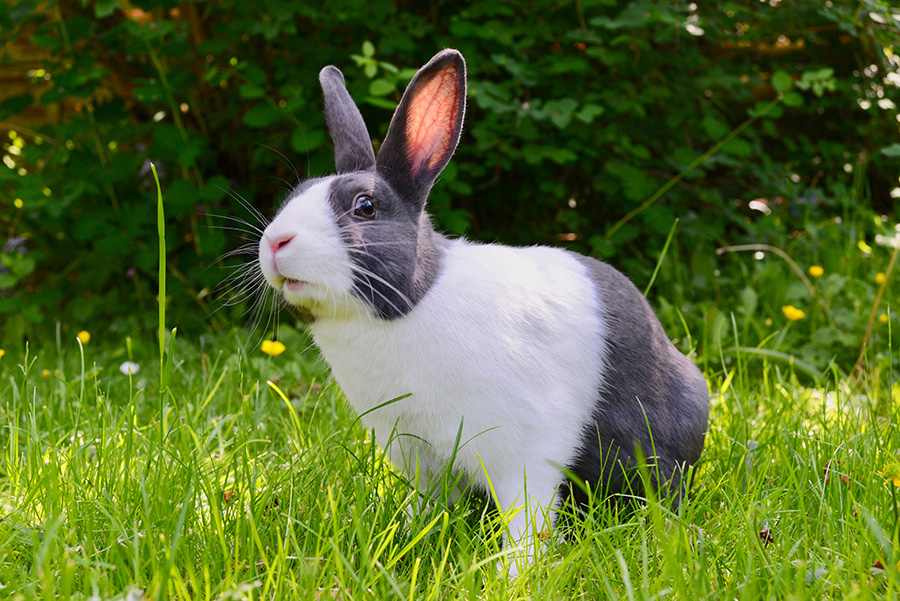Rabbits are grazing animals that are adapted to consuming a diet that is relatively low in energy and protein but very high in fibre. They gain adequate nutrition by consuming large volumes of food over several hours a day, and this wears down their constantly growing teeth.
In recent times our understanding of rabbit nutrition and how this affects health has improved greatly. This has yet to filter through to many of the rabbit food manufacturers.
The key to good rabbit feeding is fibre and the avoidance of sudden changes.
The single most important item in the rabbit diet is GRASS HAY, and it should be fed in unlimited quantities to adults and baby rabbits, and used as bedding material too.
Hay forms the basis of a healthy diet for your pet bunny, and it meets most of the nutritional requirements for the unique digestive and dental system of the rabbit. 75 % of a hutch based bunnies diet should be from grass hay.
Lucerne (also known as alfalfa) hay is best avoided in most rabbits as the high levels of calcium and protein in Lucerne hay make it unsuitable for mature rabbits. If hay is too messy for you then you could try Oxbow Hay CakesTM .
Hay is cropped grass that is left to dry in the sun. It is then baled and stored. Within 30 days of harvest vitamin content has disappeared. There is also considerable variation in the nutrient content of hay (one bale of hay is not the same as another). So hay is a good as a source of energy protein and fibre, but cannot supply the vitamins. Rabbits need high levels of fibre to promote normal movement of their digestive system and wear down those teeth and to prevent boredom. However, bunnies on hay based diets NEED a vitamin source too. This is why fresh grass and fresh vegetables, or appropriate pellets have their place.
Offer a wide variety of fresh VEGETABLES. Whatever is in season can be fed to your rabbit. All vegetables should be fresh enough that you could eat them and not left more than 24 hours in the hutch.
Things like carrot tops and strawberry tops are good starters for fussy bunnies.
Veggies that are OK include Cos Lettuce, Butter Lettuce, Red Leaf Lettuce, Asian Greens, Dandelion Greens, and carrots. Fresh leafy herbs such as Basil, Dill, Fennel, Parsley Sage and Mint are all fine. Iceberg lettuce and celery stalks in large quantities are not ideal as they are composed of mainly water, but may be given in small amounts, leafy celery tops are better.
Small amounts of fresh fruit like strawberry and apple are suitable, but in small volumes
Access to fresh grass is good, but lawn clippings should not be fed.
New items including fresh veggies should be introduced in very small amounts as your bunnies digestive system needs time to adjust.
Don’t stop feeding a certain vegetable suddenly because this can lead to all the bacteria that breakdown that plant dying off suddenly and gas and gut stasis being produced
Broccoli Cauliflower and Brussel Sprouts can lead to gas production causing digestive upsets and are best avoided.
Pellets & Mixes
A pellet is a dry food where all the individual pieces are identical.
Whilst pellets are better than mixes, not all pellets are the same. Pellets should be fed in limited quantities. If there is plenty of hay for fibre and a minimum of 4 hours a day grazing on good fresh grass and some fresh veggies for vitamins, pellets are not essential. However a good quality pellet is useful as part of an overall balanced diet especially for a bunny owner who is short of time and needs a simple routine.
A ‘rabbit mix’ is a dry food where different components such as grains seeds and kernels can be individually identified. Rabbit mixes are visually appealing and it is understandable that people want to feed their bunny something that ‘looks interesting’. All ‘rabbit mixes’ have very serious problems and should not be fed at all. Mixes were devised long before our current understanding of rabbit nutrition developed. The levels of energy and protein in these mixes are way too high whilst the fibre levels are much too low. This leads to obesity and increased risk of serious digestive and dental problems. To make matters worse these limitations can often be exacerbated by the rabbit selectively eating certain grains within the mix further increasing the risk of the above diseases
An example of a good general purpose pellet food is Oxbow Bunny Basics T TM ( aka “BBT”). Oxbow Bunny Basics 15/23TM is designed for young, pregnant or sick bunnies. Oxbow 15/23 is also great for bunnies that have been fed a “rabbit mix” diet and the owner is now looking to make the change to a healthier diet (see below).
A good quality pellet such as Oxbow can make up to 25% of the rabbits daily food intake, the remaining 75% being hay, lawn grass and some fresh veggies .
When purchasing rabbit pellets look for pellets that have a minimum of 20% fibre and less than 16% protein. Oxbow pellets meets these standards comfortably.
Unfortunately there are many of products sold as rabbit foods that do not meet these requirements so make sure you read the labels and if in doubt seek the advice of your vet. Remember that Rabbits are not Guinea Pigs, seek professional advice before feeding any product that claims to feed both species!!
Oxbow have been committed to excellence in rabbit nutrition and their products have long been recognized for their consistent high quality and palatability. Other Oxbow product lines can be ordered on request
For more information on rabbit nutrition go to www.oxbowaustralia.com
FRESH WATER should always be available
WHY HAY IS SO IMPORTANT?
Rabbits have amazing teeth. They all grow, all the time at about 2mm per week, for their entire life- that’s just like you finger nails! If the rabbit is not feeding on something that wears down the teeth continually they start to get too long and this causes enormous problems. Sometimes you will see these overgrown teeth at the front but often it is the molars hidden deep in the mouth that are affected. The overgrown roots grow backwards into the jaw and the skull and eventually you will see signs like fussy eating, lumps and drooling. A high fibre diet (ie grass or hay based) prevents this problem as rabbits need to chew it well and so it wears down the teeth as needed.
The second reason hay is important is the rabbits unique digestive system. They are coprophagous. This means they consume some of their faeces and digest it a second time. This portion is called the caecotroph. The caecotroph is the softer, sticky dropping produced about 4 hours after eating. By eating the caecotroph they get maximal vitamins and nutrition from their food. Consumption of the caecotroph is a normal and essential part of their digestive process. Usually it is not observed by the owners. When a rabbit is unwell sometimes it stops eating its caecotrophs. The soft sticky caecotroph looks very different to normal faeces and is sometimes mistaken as diarrhoea.
Production of caecotrophs requires fibre in the diet.If they have insufficient fibre they will not produce caecotrophs and can develop an inactive gut, which we call gut stasis. Gut stasis is a life threatening condition. Hay provides the fibre that prevents gut stasis and promotes normal faeces formation.
My Rabbit has been fed on a “rabbit mix” for its entire life what should I do?
It is worth trying to get your bunny onto a healthier diet. The key here is gradual change. Your bunnies’ digestive system is used to a low fibre low moisture diet and sudden changes could cause an upset. Your bunny may also be unable to recognize new more appropriate items as food. Start to use hay as bedding and introduce any new items in small amounts and over a time frame of 3-4 weeks gradually reduce the amount mix you are feeding. Gradually introduce to the rabbit mix Oxbow 15/23 pellets. This pellet is designed for growing & pregnant rabbits. The higher energy levels make it more appealing to a bunny that is used to a high energy mix. Once you have achieved the transition to Oxbow 15/23 start to transition to Oxbow Bunny Basics. If you are unable to make the transition to BBT don’t worry feeding 15/23 + hay is still a substantial improvement on what you were previously feeding.






